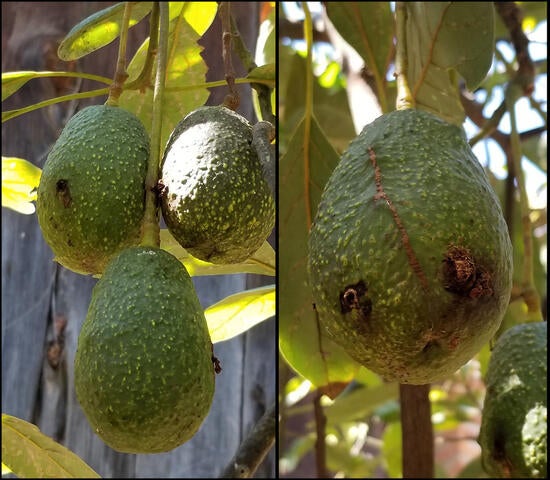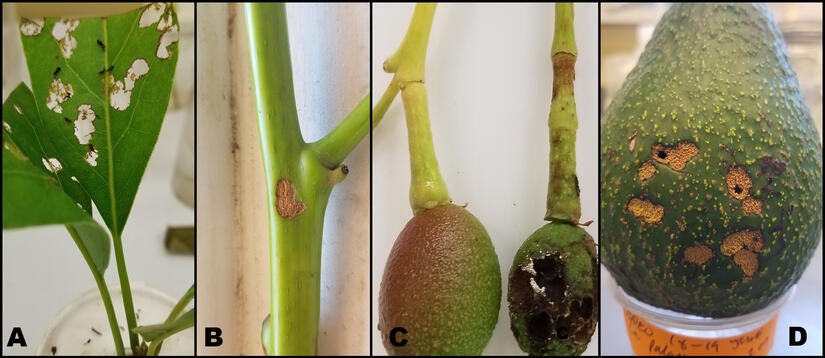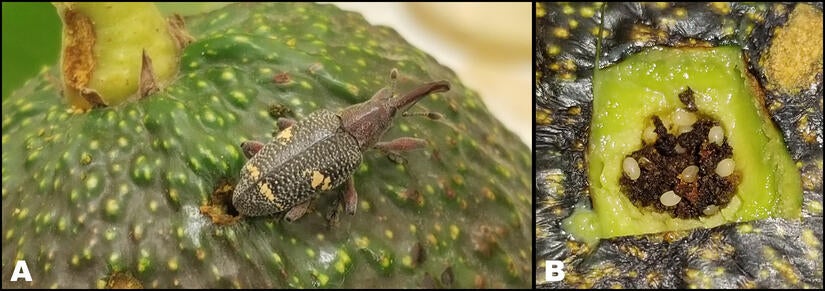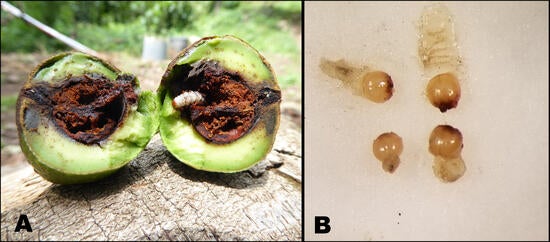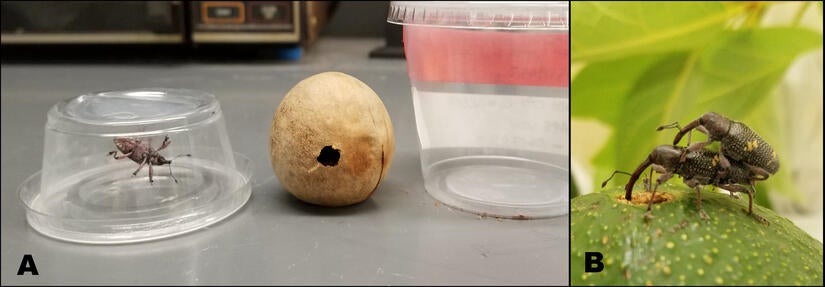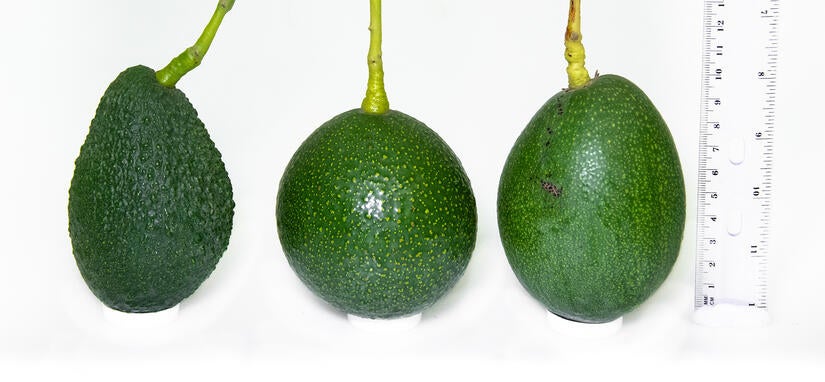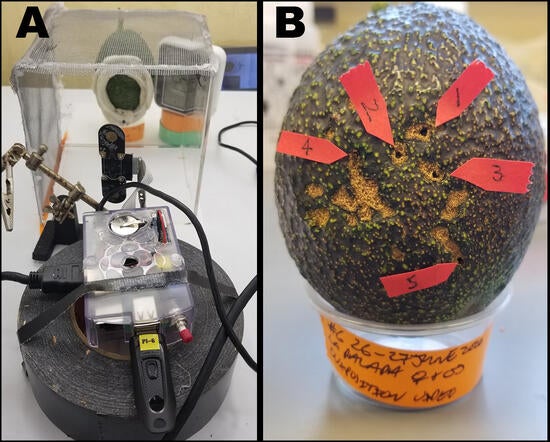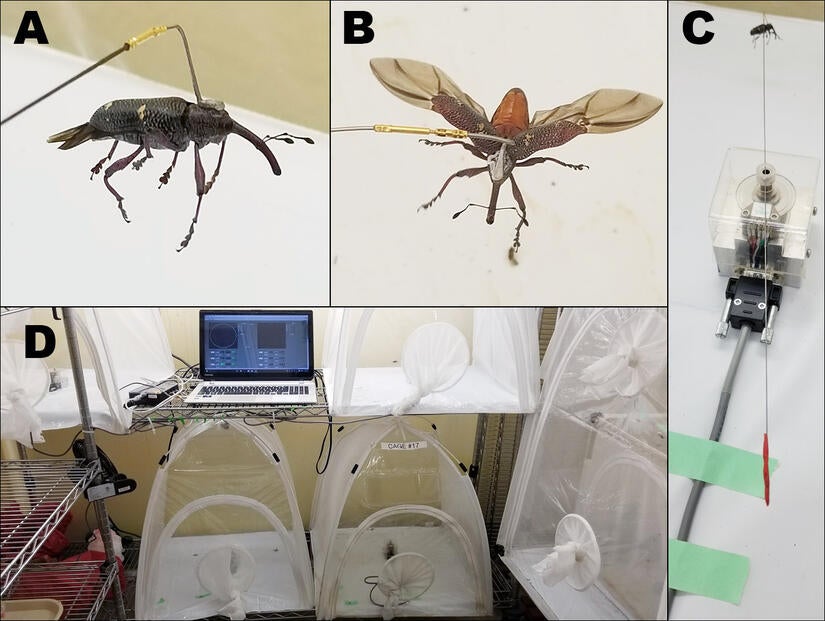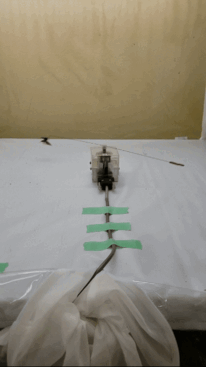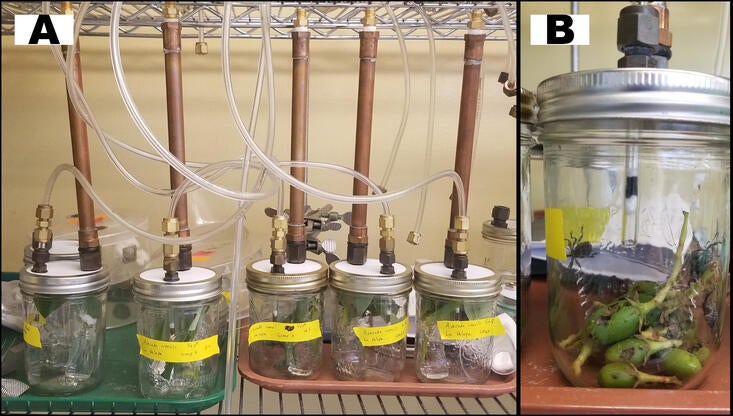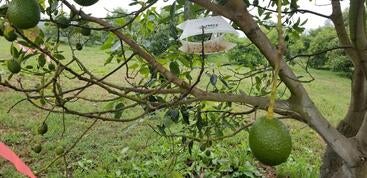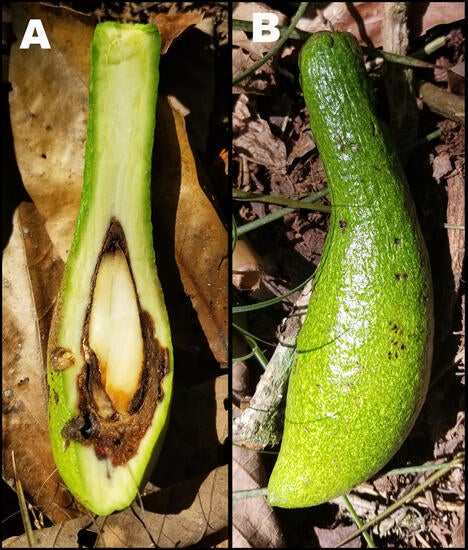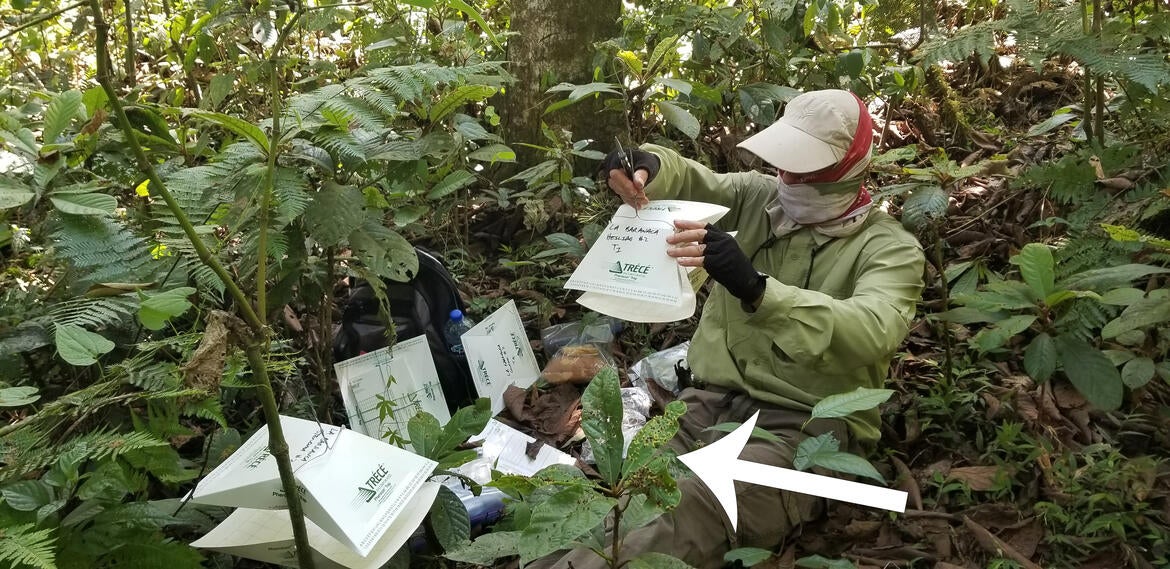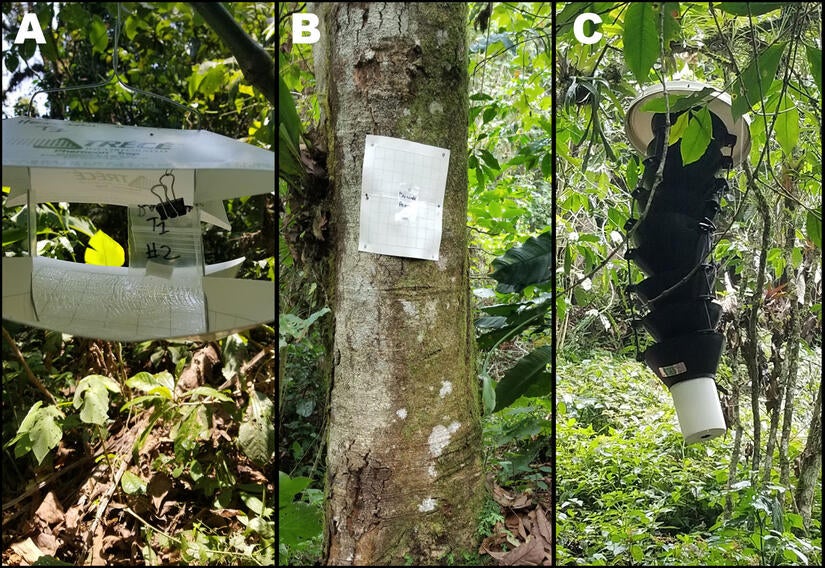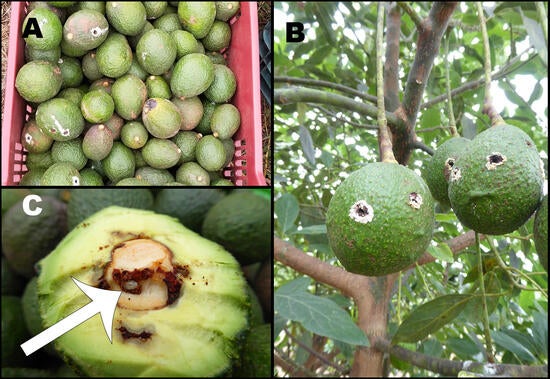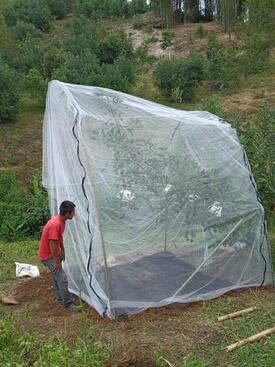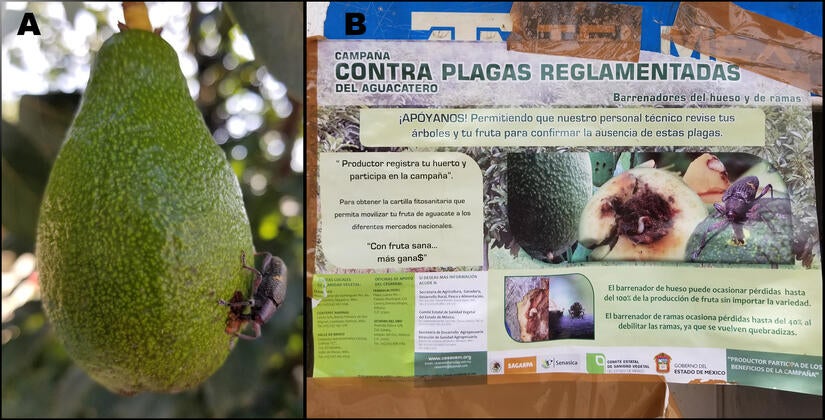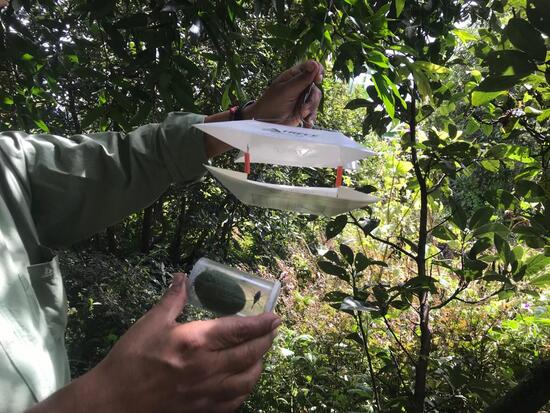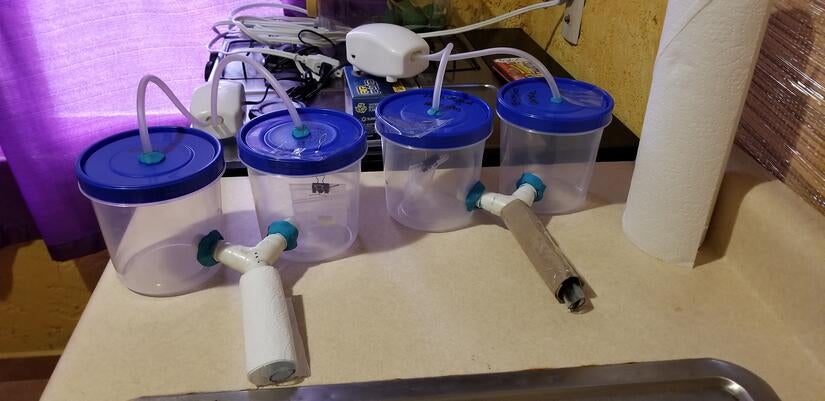The Large Avocado Seed Weevil, Heilipus lauri Boheman (Coleoptera: Curculionidae)
Mark S. Hoddle, Ph.D.Biological Control Specialist and Principal Investigator Photos and text by Dr. Mark Hoddle. | Table of ContentsThe Problem
|
The Problem: Avocado seed feeding weevils and avocado branch boring weevils in the genus Heilipus have been identified as high incursion threats to California, the largest producer of US-grown avocados, a specialty crop with a net worth of ~$350 million per year. One of these pest weevils, the big seed weevil, Heilipus lauri (Fig. 1) has been intercepted in the USA in avocado fruit exported from regions where this weevil is native (i.e., Mexico) and an invasive pest (i.e., Colombia).
Currently, California-grown avocados are free from specialist fruit feeding pests such as seed feeding weevils (H. lauri) and moths (Stenoma catenifer). Establishment of a fruit feeding pest, like H. lauri, in California, would cause significant disruption to the avocado industry because of economic losses due to feeding damage (Fig. 2), increased insecticide use, and the likely implementation of quarantines to prevent accidental pest movement within California and to eliminate export risks to trading partners who import California-grown avocados. Insecticidal control of H. lauri would be very difficult as larvae of this pest feed internally on the most economically important part of the plant, the fruit.
Avocado Seed Weevil Biology: Adult H. lauri feed on young leaves (Fig. 3A), green stems (Fig. 3B), fruit petioles, skin of immature (Fig. 3C) and mature fruit Fig. 3D), and probably avocado pulp when females drill holes into fruit to lay eggs.
In commercial Hass avocado orchards in Mexico, oviposition holes are most commonly found in the middle and bottom thirds of fruit.
In the laboratory, female weevils lay, on average, about two eggs per oviposition hole, with up to six eggs sometimes being found. Other females may add eggs to oviposition chambers, and up to 17 eggs have been found in a single oviposition hole. This finding suggests that female weevils do not use an oviposition deterring pheromone to prevent other females from exploiting occupied oviposition holes. Additionally, artificial holes in fruit, representing mechanical damage, are used by females for oviposition (Hoddle et al. 2024).
Occasionally, brown material is found around eggs in oviposition chambers. Videography studies indicate that that this material is masticated fruit epidermis that females graze from the surface of the fruit and then pack into oviposition chambers. This packing material may provide eggs protection from natural enemies or desiccation (Hoddle et al., 2024).
Larvae that hatch from eggs bore through the fruit pulp to the seed. Upon reaching the seed, larvae burrow into the seed to feed causing significant internal damage (Fig. 5A). Internal feeding activity damages fruit, making it unmarketable, and in some instances heavy damage may cause some fruit to drop prematurely. Larvae are cannibalistic and will attack and eat each other if they encounter conspecifics (Fig. 5B). This may be why field collected fruit almost always have just one weevil living in the avocado seed even though it is highly likely that more than egg was laid on that fruit (in the laboratory, individual female weevils, on average, lay around two eggs per oviposition hole).
At 21.6 ± 1.8 °C and relative humidity of 66 ± 8%, the life cycle of H. lauri, from egg to adult takes 76.14 ± 7.31 days on average, to complete. During this time, the egg stage lasts 12.70 ± 1.87 days, the larval stage encompasses 48.68 ± 6.41 days, and the pupal stage takes 14.76 ± 1.13 days to complete (Diaz Grisales et al. 2017). Larvae pass through four instars (Castañeda-Vildózola et al. 2016). In the laboratory, at 26oC (±0.01), and 56% (±0.31) %RH, on a diet of Hass avocado fruit, adult weevils can live, on average, for 203 ± 16.62 days. Under these laboratory conditions, one female lived for 539 days (Hoddle et al. 2022).
Oviposition Preferences for Fruit from Different Avocado Cultivars: In the laboratory, adult female H. lauri exhibit preferences for fruit from different avocado cultivars when given a selection of fruit to choose from (Fig. 7). In comparison to the commercially popular Hass variety, fruit from Lamb Hass and G22, a native Guatemalan variety, and to a lesser extent Gem, may be less preferred for oviposition when females have a choice of fruit in which to oviposit. These findings may have important implications for breeding new avocado varieties that have resistance to avocado fruit feeding pests (Hoddle et al. 2024).
Behavior of Heilipus lauri: Male and female H. lauri tend to be most active during the day, especially with respect to oviposition, feeding, and walking behaviors (Hoddle et al. 2024). Digital videography in the laboratory of male and female weevils over a 24 hour period (Fig. 8A), indicated that female weevils drill the majority of their oviposition holes during the day and making oviposition holes takes, on average, around 18-19 minutes to complete. It then takes females, on average, about 4 mins to lay around two eggs per oviposition hole (Fig. 8B) (Hoddle et al. 2024). Females may pack holes with masticated epidermis grazed from the surface of fruit (see Fig. 4B). Average hole packing times, including the mastication of epidermis, takes around 4 minutes to complete. Females only pack holes in which they have oviposited eggs (Hoddle et al. 2024). At night, male and female weevils spend the majority of their time, ≥75%, resting (Hoddle et al. 2024).
Weevil Flight Activity: Flight mill studies (Fig. 9), conducted in a laboratory, indicated that adult male and female H. lauri are capable of flying and weevils are capable of flying multiple consecutive times over the course of their life span (Hoddle et al. 2022). Depending on weevil age and the number of flights weevils have engaged in, flight distances can range from around 2-6 kilometers over a 24 hour period. As weevils get older and they fly more, the average flight distances decrease. The overall average flight distance, when all flight data were assessed by weevil sex, age, and flight frequency, is around 2 kilometers (Hoddle et al. 2022). Weevil flight capabilities are not affected by weevil size or the sex of the weevil. Big and small weevils, male and female weevils, all exhibit approximately similar flight capabilities when tethered to flight mills.
Flight mill studies are highly artificial as weevils are tethered to a near frictionless rotor, they fly in circles in near perfect ambient conditions (i.e., favorable temperature and humidity, and no wind) and weevils are well fed and rested before each flight trial. These conditions are unlikely to consistently exist in avocado orchards. However, flight mill data do provide an indication of flight potential under “ideal” conditions, and this information could be useful for designing quarantine and containment boundaries should incipient invasive populations of H. lauri be found in California or elsewhere.
Phase 1: Field Evaluations of the Heilipus Aggregation Pheromone in Commercial Hass Orchards: Field tests of the putative aggregation pheromone were conducted during May-June 2022, in three commercial Hass avocado orchards in Huatusco, Veracruz Mexico. All orchards had a history and confirmed presence of the avocado seed weevil, Heilipus lauri. Weevil presence was verified via field captures of weevils in experimental orchards and observations of weevil damaged fruit during the period of field evaluations.
Treatment 1, a racemic mix of grandisol, the commercial synthesized version of the putative aggregation pheromone found in extracts of volatiles collected from male weevils. The pheromone consisted of 100 microliters of racemic grandisol dispensed onto a cotton wick which was placed in a small plastic ziplock baggie. Lab evaluations demonstrated that grandisol dispersed through the bag at a daily rate shown to be attractive to a related species (boll weevil, Anthonomus grandis) that responds to racemic grandisol lures in the field. This daily diffusion rate was assumed to be similarly attractive to H. lauri.
Treatment 2, a commercially-available pheromone lure for the boll weevil, a cotton pest, that is a mix of racemic grandisol and other minor components on a grey rubber septum, from Great Lakes IPM. The grandisol in this commercial boll weevil pheromone mix is the same compound that we have identified from H. lauri extracts. Thus, we hypothesized that this commercially available pheromone might be attractive to H. lauri. If so, this would eliminate a significant manufacturing and marketing obstacle to the use of aggregation pheromones for H. lauri monitoring and control. Field evaluations were therefore needed to determine whether boll weevil pheromone lures might also attract H. lauri.
Treatment 3, a blank control lure made up of a baggie and cotton wick with no added chemicals. For field evaluations, three traps were deployed in each of six blocks, and traps hung in trees were separated by 2-3 trees. Traps were checked for weevils every seven days, and traps within blocks were then rotated. On the second inspection, 14 days after deployment, entire blocks were moved to new sectors of orchards and pheromones were replaced. On day 21, traps were inspected and rotated within blocks. On day 28, traps were examined for the final time. On day 28, experiments were terminated as no weevils were captured.
Phase 2: Field Evaluations of the Heilipus Aggregation Pheromone in Wilderness Areas: La Baranca, a wild forested area with chinini avocados, Persea schiedeana, was selected for experiments (Fig. 12). Access to “La Barranca” was from one of the commercial Hass orchards in Huatusco used for pheromone evaluations. This wilderness site was a 90 min walk down a very steep mountainside trail to a flattish area above a year round flowing river. The return hike up the orchard took 2.5 hr. Dropped fruit at the chinini site clearly exhibited high levels of H. lauri activity (Fig. 13).
Two blocks of five treatments were set up about 500 m apart and each site had about 5-10 very large chinini avocado trees with fruit (Fig. 13).
Five different treatments were deployed at each site within La Barranca (Fig. 14) consisting of: (1) a wing trap and synthetic grandisol in a baggie (Fig. 15A), (2) White panel trap nailed to tree truck with synthetic grandisol in a baggie (Fig. 15B), (3) Lindgren funnel trap with synthetic grandisol in a baggie (Fig. 15C), (4) wing trap with wick and baggie and no pheromone (control), and (5) commercially available boll weevil pheromone lure in a wing trap.
Traps were deployed for two weeks, examined, rotated, pheromones replaced, and examined after an additional two weeks. No weevils were captured and the experiments were terminated at week 4.
Phase 3: Field Evaluations of Racemic Grandisol and 1% Papayanol:
Analysis of volatiles collected from male weevils held in the quarantine facility at UCR indicated that a minor component, papayanol, was present in extracts at 1% of the quantity of grandisol. This trace component was initially considered to be unimportant and so was not incorporated into the racemic grandisol blend that was field tested above. Following the first round of negative field results, it was decided to incorporate papayanol at a concentration of 1% into the racemic grandisol blend and field test this new mixture. Thus, papayanol was synthesized and field trials with this new pheromone blend were conducted at three new sites in Huatusco Veracruz. Two of these sites were low management commercial Hass avocado orchards, and the third site was a commercial chinini nursery where plants were grown without insecticide use.
Site 1 consisted of 100 3.5 year old Hass trees with significant amounts of weevil damaged fruit hanging in trees and in picking bins (Fig. 16). Three treatments were deployed at Site 1. Treatment 1, wing traps with racemic grandisol and 1% papayanol on a cotton wick inside a small plastic baggie, Treatment 2 was the control, the cotton wick without pheromone in the plastic baggie, and Treatment 3, the commercially-available boll weevil pheromone from Great Lakes IPM. Additionally, 1 Lindgren trap was set up with the cotton wick infused with racemic grandisol and 1% papayanol inside the plastic baggie. Treatments were deployed in five blocks, examined weekly and rotated within blocks. At the 14 day mark, blocks were rotated, traps were checked, and pheromones were replaced. At week three, traps were inspected and rotated. At day 28 traps were inspected for the last time and the trial was terminated as no weevils were captured.
Site 2, about 2 miles from Site 1, with very similar trees and weevil infestation levels, was set up identically to Site 1 and traps were checked and rotated on the same inspection schedules. No weevils were captured in traps at Site 2.
Site 3 was a commercial chinini nursery with plants being grown under shade covers (Fig. 17). Plants were not treated with insecticides and growers were very familiar with H. lauri as adult weevils are significant foliar pests feeding on young growth. Two blocks of the three treatments were deployed inside the covered shade structures where trees were being grown. The same inspection, rotation, and pheromone replacement schedules were followed as described above for Sites 1 and 2. No weevils were captured.
Phase 4: Field Cage Study to Assess Pheromone Attractiveness to Weevils
A new approach to testing the attractiveness of racemic grandisol and 1% papayanol to adult weevils was undertaken, and used a single replicate of a small field cage (Fig. 18). A large branch with immature fruit on a 4 year old unsprayed Hass avocado tree, approximately 4 meters tall, was enclosed with a custom-built mesh cage. Grass and weeds were dug out from underneath the enclosed branch and the floor of the cage consisted of weed mat to reduce the likelihood of weevils finding hiding places on the ground or escaping. The edges of the cage and weed mat were buried under the ground to prevent weevil escape. A zipped door permitted access into the cage. Inside the cage the three treatments of interest were set up. Treatment one consisted of a wing trap with the racemic grandisol and 1% papayanol additive on a cotton wick inside a plastic baggie. Treatment 2, the control, was a wing trap with the cotton wick inside the baggie and lacked the pheromone. Treatment 3 was a wing trap with the commercially available boll weevil pheromone from Great Lakes IPM.
Six adult (three females and three males) field collected weevils were introduced into this cage. Prior to introduction, adults were held for one week in ventilated vials and fed with small avocado fruit. During this time adults were observed copulating.
After two weeks inside the cage, the six adults, all alive, were recovered from the tree and no weevils were trapped in any of the baited traps.
Phase 5: Field Tests to Determine if Trap Color and Trap Type Affected Attraction of Weevils to Aggregation Pheromone
A review of literature on using pheromones to trap weevils indicated that trap color and trap design (e.g., sticky panel traps nailed to trunks and branches) can have significant impacts on trapping efficacy. In July 2022, a four week trial in three commercial but very poorly managed Hass avocado orchards in State of México was set up (Fig. 19). This study site is ~300 miles from Huatusco, and very close to where the original weevils used for pheromone work in the UCR I & Q facility were collected. Weevil damage to fruit across all three orchards by visual observation of 210 hanging fruit was estimated at 63%.
Four different trap colors, blue, green, yellow, white, and black Lindgren funnel traps, with and without pheromone were tested for attractiveness to weevils (Fig. 20). Colored panel traps were wrapped around tree trunks in orchards and nailed to trunks to hold them in place. In particular, these trunk traps were accessible to both walking and flying weevils, in case weevils walk rather than fly to pheromone sources.
In each of three orchards, two blocks were set up. Each block consisted of each panel trap color and the Lindgren trap and each was replicated twice. For example, in block one there were two white traps; one had the racemic grandisol and 1% papayanol and the other white trap was the paired control and consisted of the cotton wick inside the plastic baggie and lacked pheromone. For each orchard a total of 20 traps were deployed (four white [2 pheromones and 2 controls], four green [2 pheromones and 2 controls], four yellow [2 pheromones and 2 controls], four blue [2 pheromones and 2 controls], and four black Lindgren traps [2 pheromones and 2 controls]), for a grand total of 60 traps for the entire trial.
Following deployment, traps were checked after 7 days and rotated. At day 14, pheromone lures were replaced, and blocks rotated. Day 21, traps were checked and rotated within blocks. On day 28, traps were checked and the experiment was terminated. No weevils were trapped.
Phase 6: Field Tests with Caged Live Mating Pairs of Adult Weevils: In October-November 2022, another set of experiments was set up in Mexico. Twenty one pairs of adult laboratory-reared weevils between 1 and 2 months of age were caged in ventilated vials with small avocado fruit to feed on and placed inside wing traps deployed at three field sites (Fig. 21). The goal of this work was to verify that the weevils were indeed releasing and using volatile pheromones to attract conspecifics. After four weeks the trial was terminated as no weevils were trapped and all adults inside ventilated vials were alive. These negative results do not necessarily mean that weevils are not releasing and responding to an aggregation pheromone. It is possible that caged mating weevil pairs do not release grandisol to attract conspecifics if they are already mated or in the process of mating.
Phase 7: Home-made Olfactometer Kitchen Assays to Test the Attractiveness of the Racemic Grandisol to Adult Male and Female Weevils: Rough and ready kitchen bioassays were conducted in Huatusco to determine the attractiveness of the racemic grandisol to adult male and female weevils. Olfactometers (Fig. 22) were made from irrigation supplies obtained from a hardware store, plastic pots, and aquarium pumps that had two ports that simultaneously delivered air at a rate of 2 liters per minute. Field collected weevils of unknown age and mating status (all were assumed mated as copulation was regularly observed in colonies), maintained in ventilated containers with young avocados and flush growth to feed on were used for experiments. Adult weevils were introduced into clear irrigation piping attached to the “y-tube”. Pipe and y-tube were slightly angled upwards and the clear pipe was covered removing direct light into the pipe. These two design features, upward angled piping and lack of light, were intended to encourage weevils to walk into the air source and towards the light. Positive geotaxis and phototaxis are typical behavioral responses by diurnal insects. A total of 127 trials were conducted; weevils were visually observed and time to make a decision was recorded. After each trial the olfactometer set up was completely disassembled, thoroughly cleaned with 95% ethanol, rinsed with purified drinking water, dried with paper towels, and then left for a minimum of 1 hr to complete air drying. The olfactometer was then reassembled for the next experiment. Position of pots with pheromone and control treatments lacking pheromone were swapped between trials to eliminate potential bias from position effects. The average room temperature for experiments was ~24oC. Trials were conducted over the course of a day and the number of replicates completed per day was dependent on weevil availability.
Trial One: 86 (46 females and 40 males were tested) trials with racemic grandisol (i.e., grandisol on the cotton wick inside a plastic baggie) suspended inside one container and the blank control (i.e., wick lacking pheromone inside the baggie) in the other container were conducted. Results: 35% of weevils (19 males and 11 females) went to the pot with the racemic grandisol mixture. 16% of weevils (6 females and 8 males) were neutral, they failed to leave the y-tube after 3 hours. 49% (21 females and 21 males) of weevils entered the control pot.
Trial 2: 36 (23 females and 13 males) trials testing racemic grandisol and 1% papayanol with a paired control. Results: 25% of weevils (8 females and 1 male) responded positively to the pheromone. 8% of weevils (3 females) exhibited a neutral response, and 67% of weevils (12 females and 12 males) responded positively to the control.
Trial 3: 5 (2 females and 3 males) trials testing head-to-head racemic grandisol vs. racemic grandisol and 1% papayanol. Results: 4 weevils (1 female and 3 males) responded positively to the racemic grandisol and 1 female (20%) responded to the racemic grandisol and 1% papayanol.
The total time weevils took to demonstrate a choice outcome was as follows 61% entered a container < 1 hr of the trial starting, 24% took ~ 1 hr, 15% 2 hrs, and ~1% > 3 hrs (neutral responses). Of those weevils responding within the first 59 mins of the olfactometer assay, 44% responded in < 10 mins, 21% 11-20 mins, 16% 21-30 mins, 9% 31-40 mins, 4% 41-50 mins, and 6% 51-59 mins.
Overall preliminary statistical analyses indicate that weevils showed no clear unambiguous preference for the racemic grandisol mixture or grandisol and 1% papayanol when compared to the control treatments. There are potentially many confounding factors with this study. We don’t know the effects of mating status on responses to the pheromone, weevil age was not controlled for, time of day experiments were run was not controlled for (it is possible that weevils are receptive to pheromone at only certain times of the day, perhaps the morning, and possibly within a very specific time window in the morning [e.g., 6-9:30am]), and we only tested one pheromone dose.
Conclusions: At this stage, field experiments with the racemic mix of grandisol and the racemic mix plus 1% papayanol indicate zero attractiveness in the field to H. lauri. This result was consistent across two field sites, located in the states of Veracruz and Mexico, which are separated by a distance of ~300 miles. Additionally, weevils from field sites in the state of Mexico were very close to sites from which weevils were originally collected for pheromone work in the Quarantine Facility at UCR. Therefore, any concerns about weevil biotypes in widely separate areas having different pheromones can be discarded. However, to confirm this assumption that different biotypes/cryptic species of H. lauri don’t exist in these test regions would require molecular analyses.
The high level of uncertainty and speculation over interpreting results is due, in large part, to there being so little known about the reproductive biology and behavior of H. lauri. At this stage, the last best, and arguably definitive approach, is to field test the pure grandisol enantiomer in Hass orchards heavily infested with H. lauri for attractiveness.
Background Reading
- Caicedo, L.R., E.V. Devia, T. Bacca, and A. Carabali. 2010. Daños ocasionados por el perforador del aguacate Heilipus lauri Boheman (Coleoptera: Curculionidae) en Tolima (Colombia). Revista Corpoica - Ciencia y Tecnología Agropecuaria 11: 129-136.
- Castañeda-Vildózola, A., H. González-Hernández, A. Equihua-Martínez, J. Valdez-Carrasco, J. E. Peña, and L. E. Cazado. 2016. Head capsule width is useful for determining larval instar in Heilipus lauri (Coleoptera: Curculionidae). Fla. Entomol. 99: 822-825.
- Diaz Grisales, V., A. M. Caicdeo Vallejo, and A. Carabalí Muñoz. 2017. Ciclo de vida y descripción morfológica de Heilipus lauri Boheman (Coleoptera: Curculionidae) en Colombia. Acta Zool. Mex. 33: 231-242. Hoddle, M.S., C.D.
- Hoddle, E.G. Estrada-Venegas, A. Equihua-Martínez, and I. Milosavljević. 2022. Assessment of age, gender, mating status, and size on single and repeat flight capabilities of Heilipus lauri (Coleoptera: Curculionidae). Journal of Insect Science 22: 1-12. https://doi.org/10.1093/jisesa/ieac011 Hoddle, M.S., C.D.
- Hoddle, I. Milosavljević, E.G. Estrada-Venegas, and A. Equihua-Martínez. 2024. Oviposition biology, behavior, and avocado cultivar preferences of Heilipus lauri Boheman (Coleoptera: Curculionidae). Journal of Insect Science 24(5): 1; ieae099 https://doi.org/10.1093/jisesa/ieae099
- Romero-Frías, A. A., D. C. Sinuco, J. M. S. Bento. 2019. Male-specific volatiles released by the big avocado seed weevil Heilipus lauri Boheman (Coleoptera: Curculionidae). J. Braz. Chem. Soc. 30: 158-163.


